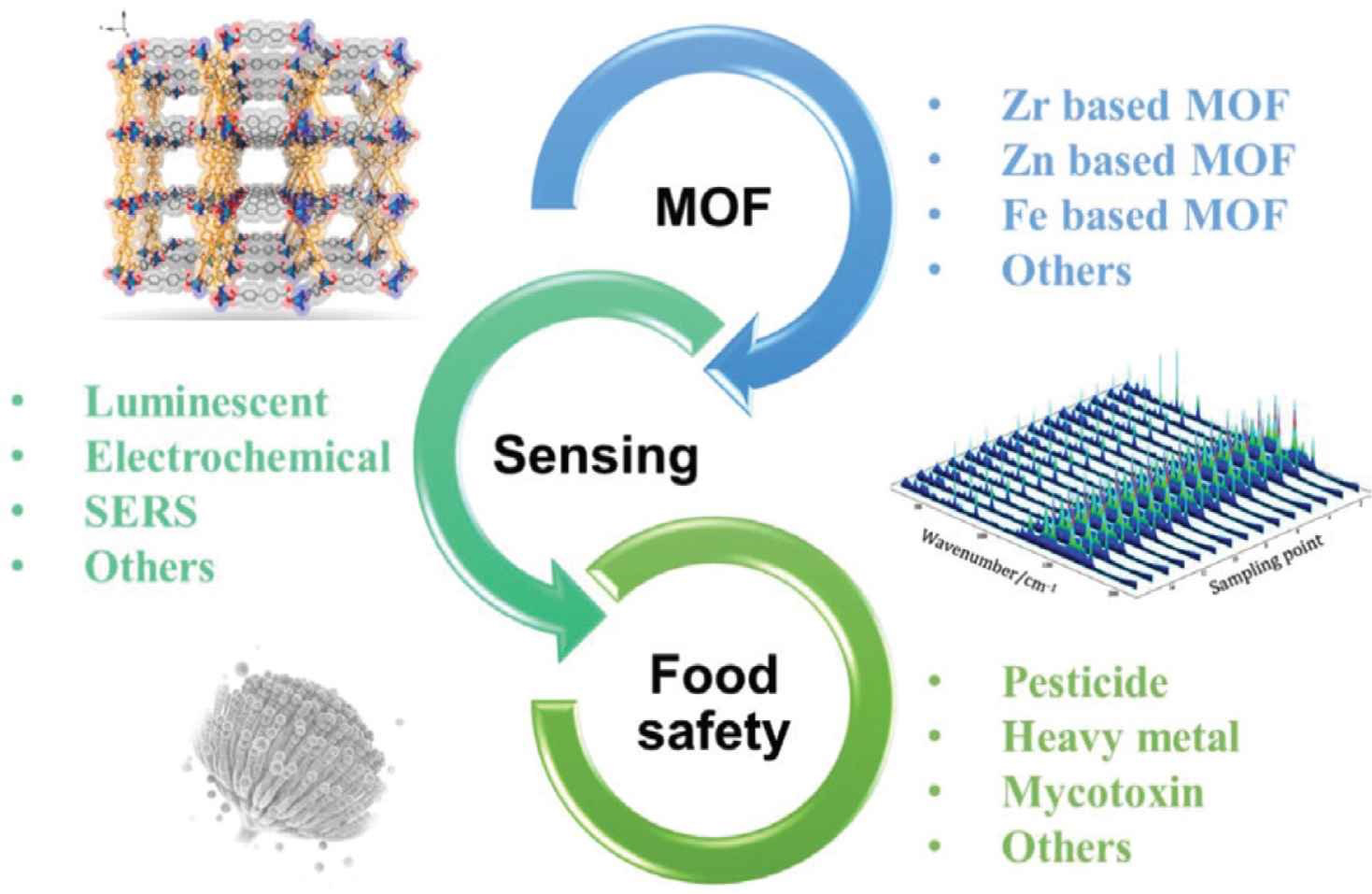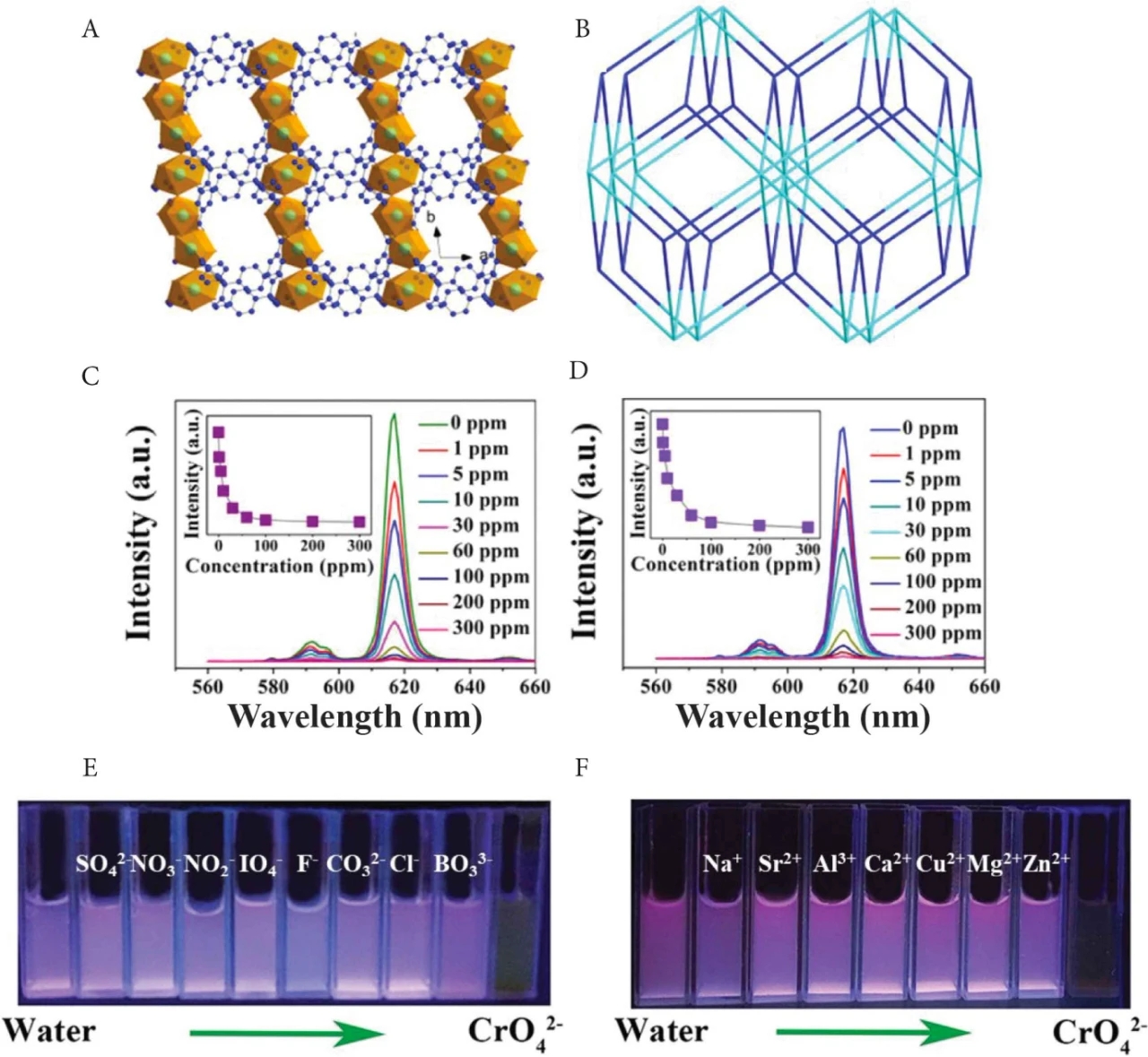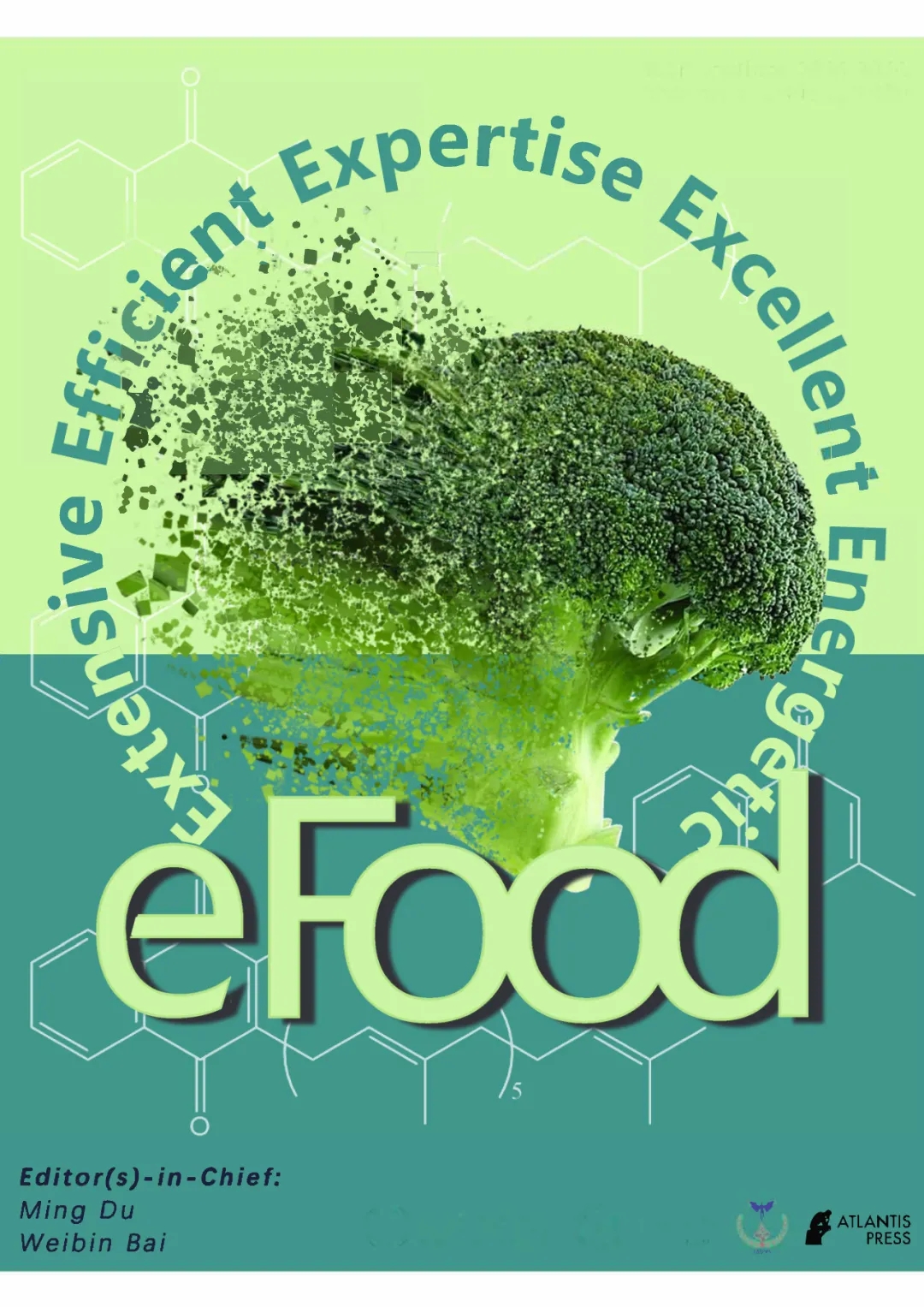博文
文章荐读 | 基于金属有机框架(MOFs)的食品安全评价分析技术
||
小编导读
现如今,随着全球食品供应链的日益全球化和复杂化,食品安全问题因其对整个生态系统的广泛污染及其对人类福祉的影响程度而备受关注。来自澳门大学中医药研究所、湖南中医药大学和四川省食品药品监督管理研究所的学者们在期刊eFood上发表了题为“Metal−Organic Frameworks (MOFs) Based Analytical Techniques for Food Safety Evaluation”的综述文章,研究了基于金属有机框架(MOFs)的食品安全评价分析技术。
要点介绍
食品是人类生活中必不可少的一部分,然而近年来出现了很多食品安全问题。根据世界卫生组织的报告,世界上可能有200多种疾病都是由食物传播的,比如癌症。由于食品安全与所有人的健康和福祉密切相关,通过国家和国际层面的政策和法规制定,食品安全的重要性已得到越来越多的认可。
相应地,人们对检测甚至吸附食品中污染物的各种分析方法也进行了广泛的探索和研究。其中,金属有机骨架(MOFs)作为一种潜在的多功能传感材料,已被用于构建多种性能优异的传感平台,用于监测食品中的各种污染物,包括农药残留、重金属、真菌毒素等。
本文简要介绍了基于MOFs的传感技术的进展,并介绍了几种典型的传感平台在农药、重金属等污染物检测中的典型贡献。最后,我们评估和讨论了MOFs在食品污染物分析中的未来前景和挑战。

图1. GRAPHICAL ABSTRACT

图2. (A)沿Eu-MOF的c轴观察的三维(3D)网络结构。(B) 它的拓扑结构显示了(4,8)连通的三维框架。Eu-MOF在不同铬浓度的湖水(C)和海水(D)中的PL光谱。显示淬火过程的插图。Eu-MOF在不同阴离子(E)或阳离子(F)溶液中(激发波长为365nm)的发光照片。
研究结论:文章综述了近年来MOFs传感器的技术进展及其在农药残留、重金属等有毒物质检测中的具体应用。MOFs具有可修改的孔隙结构、大的表面积和高活性点密度等优点,成为食品污染传感平台开发的优良传感材料。特别是,新型MOF与其他功能材料结合,提高了传感性能,从而增强了其通用性。
MOF与分析物之间的电子传递是电化学检测方法的主要检测机制。同样,由于金属离子与MOF中特定部分或原子之间的强相互作用,在传感策略中也经常存在能量传递。此外,识别元件的修改和信号放大也被用于基于MOF的敏感和选择性检测。
MOF的应用有望克服主要由水不稳定性引起的一系列限制,从而提高其在水环境中的灵敏度、选择性和再现性。首先,通过更好地了解MOFs的功能,特别是开发适合于食品基质的MOF快速方法(如诊断试剂盒和条带),可以最大限度地优化和利用MOFs的功能优势,使其在食品工业中的应用得到更大的应用。其次,考虑到食品中存在多种污染物的可能性较大,设计了多功能MOF材料。第三,基于MOFs的检测平台的特异性有望提高,因为目前大多数MOF都无法从结构相似的农药家族中检测到特定的分析物。最后,希望开发出更多的多功能MOF材料,同时在食品中传感、捕获和去除目标分析物。
参考文献 References
[1] Griffiths E, Dooley D, Graham M, Van Domselaar G, Brinkman FSL, Hsiao WWL. Context is everything: harmonization of crit- ical food microbiology descriptors and metadata for improved food safety and surveillance. Front Microbiol 2017;8:1068.
[2] Bai W, Du M. A new open access forum in global food and health science. eFood 2020;1:1.
[3] Cheng S, Tu M, Liu H, Zhao G, Du M. Food-derived antithrom- botic peptides: preparation, identification, and interactions with thrombin. Crit Rev Food Sci Nutr 2019;59:S81–S95.
[4] World Health Organization. WHO estimates of the global burden of foodborne diseases. Foodborne diseases burden epide- miology reference group 2007-2015. Geneva, Switzerland: WHO; 2015, p. 265. Available from: https://www.who.int/foodsafety/ publications/foodborne_disease/fergreport/en/.
[5] Aung MM, Chang YS. Traceability in a food supply chain: safety and quality perspectives. Food Control 2014;39:172–84.
[6] Lam HM, Remais J, Fung MC, Xu L, Sun SSM. Food supply and food safety issues in China. Lancet 2013;381:2044–53.
[7] Lu Y, Song S, Wang R, Liu Z, Meng J, Sweetman AJ, et al. Impacts of soil and water pollution on food safety and health risks in China. Environ Int 2015;77:5–15.
[8] Wang PL, Xie LH, Joseph EA, Li JR, Su XO, Zhou HC. Metal– organic frameworks for food safety. Chem Rev 2019;119: 10638–90.
[9] Zhang M, Zeiss MR, Geng S. Agricultural pesticide use and food safety: California’s model. J Integr Agric 2015;14:2340–57.
[10] Wei J, Xue Y, Dong J, Wang S, Hu H, Gao H, et al. A new fluores- cent technique for pesticide detection by using metal coordina- tion polymer and nanozyme. Chin Med 2020;15:22.
[11] Dixon SJ, Stockwell BR. The role of iron and reactive oxygen species in cell death. Nat Chem Biol 2014;10:9–17.
[12] Zecca L, Youdim MBH, Riederer P, Connor JR, Crichton RR. Iron, brain ageing and neurodegenerative disorders. Nat Rev Neurosci 2004;5:863–73.
[13] Tao Y, Xie S, Xu F, Liu A, Wang Y, Chen D, et al. Ochratoxin A: toxicity, oxidative stress and metabolism. Food Chem Toxicol 2018;112:320–31.
[14] Lu Q, Qin JA, Fu YW, Luo JY, Lu JH, Logrieco AF, et al. Modified mycotoxins in foodstuffs, animal feed, and herbal medicine: a systematic review on global occurrence, transformation mechanism and analysis methods. TrAC Trends Anal Chem 2020;133:116088.
[15] Pierrard MA, Kestemont P, Delaive E, Dieu M, Raes M, Silvestre F. Malachite green toxicity assessed on Asian catfish primary cultures of peripheral blood mononuclear cells by a proteomic analysis. Aquat Toxicol 2012;114–115:142–52.
[16] Gopinathan R, Kanhere J, Banerjee J. Effect of malachite green tox- icity on non target soil organisms. Chemosphere 2015;120:637–44.[17] El-Sayed ESM, Yuan D. Waste to MOFs: sustainable linker, metal, and solvent sources for value-added MOF synthesis and applications. Green Chem 2020;22:4082–104.
[18] Stock N, Biswas S. Synthesis of metal-organic frameworks (MOFs): routes to various MOF topologies, morphologies, and composites. Chem Rev 2012;112:933–69.
[19] Fang X, Zong B, Mao S. Metal–organic framework-based sen- sors for environmental contaminant sensing. Nano-Micro Lett 2018;10:64.
[20] Masiá A, Suarez-Varela MM, Llopis-Gonzalez A, Picó Y. Determination of pesticides and veterinary drug residues in food by liquid chromatography-mass spectrometry: a review. Anal Chim Acta 2016;936:40–61.
[21] Narenderan ST, Meyyanathan SN, Babu B. Review of pesticide residue analysis in fruits and vegetables. Pre-treatment, extraction and detection techniques. Food Res Int 2020;133:109141.
[22] Teng Z, Jiang X, He F, Bai W. Qualitative and quantitative meth- ods to evaluate anthocyanins. eFood 2020;1:339–46.
[23] Wagner M, Lin KYA, Oh WD, Lisak G. Metal-organic frame- works for pesticidal persistent organic pollutants detection and adsorption – a mini review. J Hazard Mater 2021;413:125325.
[24] Islamoglu T, Chen Z, Wasson MC, Buru CT, Kirlikovali KO, Afrin U, et al. Metal–organic frameworks against toxic chemicals. Chem Rev 2020;120:8130–60.
[25] Chang Z, Yang DH, Xu J, Hu TL, Bu XH. Flexible metal–organic frameworks: recent advances and potential applications. Adv Mater 2015;27:5432–41.
[26] Raza W, Kukkar D, Saulat H, Raza N, Azam M, Mehmood A, et al. Metal-organic frameworks as an emerging tool for sensing various targets in aqueous and biological media. TrAC Trends Anal Chem 2019;120:115654.
[27] Bai Y, Dou Y, Xie LH, Rutledge W, Li JR, Zhou HC. Zr-based metal–organic frameworks: design, synthesis, structure, and applications. Chem Soc Rev 2016;45:2327–67.
[28] Hao JN, Yan B, A water-stable lanthanide-functionalized MOF as a highly selective and sensitive fluorescent probe for Cd2+. Chem Commun (Camb) 2015;51:7737–40.
[29] Wang Y, Wang L, Huang W, Zhang T, Hu X, Perman JA, et al. A metal–organic framework and conducting polymer based elec- trochemical sensor for high performance cadmium ion detec- tion. J Mater Chem A 2017;5:8385–93.
[30] Lin X, Gao G, Zheng L, Chi Y, Chen G. Encapsulation of strongly fluorescent carbon quantum dots in metal–organic frameworks for enhancing chemical sensing. Anal Chem 2014;86:1223–8.
[31] Chen H, Fan P, Tu X, Min H, Yu X, Li X, et al. A bifunctional luminescent metal–organic framework for the sensing of para- quat and Fe3+ions in water. Chem Asian J 2019;14:3611–19.
[32] Cai Y, Wu Y, Xuan T, Guo X, Wen Y, Yang H. Core–shell Au@ metal–organic frameworks for promoting Raman detection sensitivity of methenamine. ACS Appl Mater Interfaces 2018; 10:15412–17.
[33] Liao J, Wang D, Liu A, Hu Y, Li G. Controlled stepwise- synthesis of core-shell Au@MIL-100 (Fe) nanoparticles for sen- sitive surface-enhanced Raman scattering detection. Analyst 2015;140:8165–71.
[34] Li H, Han Y, Shao Z, Li N, Huang C, Hou H. Water-stable Eu-MOF fluorescent sensors for trivalent metal ions and nitro- benzene. Dalton Trans 2017;46:12201–8.
[35] Ye J, Bogale RF, Shi Y, Chen Y, Liu X, Zhang S, et al. A water- stable dual-channel luminescence sensor for UO2+ ions based on an anionic terbium(III) metal–organic framework. Chemistry 2017;23:7657–62.
[36] Bhardwaj SK, Bhardwaj N, Mohanta GC, Kumar P, Sharma AL, Kim KH, et al. Immunosensing of atrazine with antibody- functionalized Cu-MOF conducting thin films. ACS Appl Mater Interfaces 2015;7:26124–30.
[37] Fan L, Wang F, Zhao D, Sun X, Chen H, Wang H, et al. Two cadmium(II) coordination polymers as multi-functional lumi- nescent sensors for the detection of Cr(VI) anions, dichloroni- troaniline pesticide, and nitrofuran antibiotic in aqueous media. Spectrochim Acta A Mol Biomol Spectrosc 2020;239:118467.
[38] Zhu H, Kannan K. Occurrence of melamine and its derivatives in breast milk from the United States and its implications for exposure in infants. Environ Sci Technol 2019;53:7859–65.
[39] Bao J, Hou C, Chen M, Li J, Huo D, Yang M, et al. Plant esterase– chitosan/gold nanoparticles–graphene nanosheet composite-based biosensor for the ultrasensitive detection of organophosphate pesticides. J Agric Food Chem 2015;63:10319–26.
[40] Wang A, Costello S, Cockburn M, Zhang X, Bronstein J, Ritz B. Parkinson’s disease risk from ambient exposure to pesticides. Eur J Epidemiol 2011;26:547–55.
[41] Sun Y, Wei J, Zou J, Cheng Z, Huang Z, Gu L, et al. Electrochemical detection of methyl-paraoxon based on bifunctional nanozyme with catalytic activity and signal amplification effect. J Pharm Anal 2020 [in press].
[42] Vikrant K, Tsang DCW, Raza N, Giri BS, Kukkar D, Kim KH. Potential utility of metal–organic framework-based platform for sensing pesticides. ACS Appl Mater Interfaces 2018;10:8797–817.
[43] Sahoo M, Vishwakarma S, Panigrahi C, Kumar J. Nanotechnology: current applications and future scope in food. Food Front 2020:1–20.[44] Patel H, Rawtani D, Agrawal YK. A newly emerging trend of chitosan-based sensing platform for the organophosphate pesti- cide detection using acetylcholinesterase- a review. Trends Food Sci Technol 2019;85:78–91.
[45] He K, Li Z, Wang L, Fu Y, Quan H, Li Y, et al. A water-stable luminescent metal-organic framework for rapid and visible sens- ing of organophosphorus pesticides. ACS Appl Mater Interfaces 2019;11:26250–60.
[46] Deep A, Bhardwaj SK, Paul AK, Kim KH, Kumar P. Surface assembly of nano-metal organic framework on amine function- alized indium tin oxide substrate for impedimetric sensing of parathion. Biosens Bioelectron 2015;65:226–31.
[47] Wei W, Wang J, Tian CB, Du SW, Wu KC. A highly hydrolyt- ically stable lanthanide organic framework as a sensitive lumi- nescent probe for DBP and chlorpyrifos detection. Analyst 2018;143:5481–6.
[48] Guo C, Jin Q, Wang Y, Ding B, Li Y, Huo J, et al. Developing a unique metal-organic framework-{[Cd(abtz)2(NCS)]·(ClO4)}n(abtz = 1-(4-aminobenzyl)-1,2,4-triazole) as fluorescent probe for highly selective and sensitive detection of ascorbic acid in biological liquid. Sens Actuat B 2016;234:184–91.
[49] Tao CL, Chen B, Liu XG, Zhou LJ, Zhu XL, Cao J, et al. A highly luminescent entangled metal-organic framework based on pyri- dine-substituted tetraphenylethene for efficient pesticide detec- tion. Chem Commun (Camb) 2017;53:9975–8.
[50] Feng DD, Zhao YD, Wang XQ, Fang DD, Tang J, Fan LM, et al. Two novel metal-organic frameworks based on pyridyl- imidazole-carboxyl multifunctional ligand: selective CO2 cap- ture and multiresponsive luminescence sensor. Dalton Trans 2019;48:10892–900.
[51] Wang XQ, Feng DD, Tang J, Zhao YD, Li J, Yang J, et al. A water-stable zinc(II)-organic framework as a multiresponsive luminescent sensor for toxic heavy metal cations, oxyanions and organochlorine pesticides in aqueous solution. Dalton Trans 2019;48:16776–85.
[52] Li Q, Gong S, Zhang H, Huang F, Zhang L, Li S. Tailored necklace-like Ag@ZIF-8 core/shell heterostructure nanowires for high-performance plasmonic SERS detection. Chem Eng J 2019;371:26–33.
[53] Wen S, Zeng T, Liu L, Zhao K, Zhao Y, Liu X, et al. Highly sen- sitive and selective DNA-based detection of mercury(II) with` -hemolysin nanopore. J Am Chem Soc 2011;133:18312–17.
[54] Xu XY, Yan B. Fabrication and application of a ratiometric and colorimetric fluorescent probe for Hg2+ based on dual-emissive metal–organic framework hybrids with carbon dots and Eu3+. J Mater Chem C 2016;4:1543–9.
原文信息
Y. Xue, Y. Peng, Z. Geng, Y. Wang, C. Oi Lam Un, H. Hu, "Metal−Organic Frameworks (MOFs) Based Analytical Techniques for Food Safety Evaluation", eFood, 2021, DOI: https://doi.org/10.2991/efood.k.210209.001; eISSN 2666-3066.

扫描二维码,获取英文原文
https://www.atlantis-press.com/journals/efood/125952846

eFood(eISSN 2666-3066)是完全由中国学者发起,与Atlantis Press合作出版的食品科学及工程领域国际期刊,以应对全球食品和健康方面的挑战。目前已发表内容涵盖食品化学、营养健康、食品安全与检测等领域,已获得13,000多次全文下载, 并已被食品科技领域国际刊物如Advanced Drug Delivery Reviews (IF 13.3),TrAC Trends in Analytical Chemistry (IF 9.801),Critical Reviews in Food Science and Nutrition (IF 7.862),Food Chemistry (IF 6.306) 等期刊引用多次。
eFood 采用钻石开放获取出版模式,作者和读者均无需付费。目前新投稿平均一审周期23.9天,文章接收后到快速上线平均3-5天。目前,期刊已被食品科学与技术领域著名国际数据库FSTA收录,同时已被Ulrichsweb, DOAJ, Google Scholar, 中国知网, 万方数据库等收录。

Atlantis Press是科学、技术和医学(STM)领域的全球开放获取出版品牌,2006年创立于法国巴黎,在巴黎、阿姆斯特丹、北京、郑州和香港设有办事处。我们的使命是通过促进科研界和整个社会更有效地传播和交流知识来支持科学、技术和医学研究的进步。迄今,Atlantis Press的数字内容平台包含超过14万篇开放获取论文供读者免费下载阅读,每年产生2500多万下载量。Atlantis Press是施普林格·自然的一部分。
版权声明:
*本文内容由Atlantis Press中国办公室编辑。欢迎转发。如需转载,请在留言区留言,或联系xin.guo@atlantis-press.com。
https://wap.sciencenet.cn/blog-3453320-1281097.html
上一篇:文章荐读 | 基于比例犹豫模糊语言优先Choquet聚合算子的教学成果评价
下一篇:合辑荐读 |网络与分布式计算国际期刊